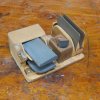Odie
Panning for Montana gold, with Betsy, the mule!
Just wondered if anyone has done any reshaping or otherwise altering of a hard Arkansas stone.......?
I'm tempted to try some 60gt 6x48 belt, or grinder wheel, but thought I'd ask here and see if anyone has tried that first......
The new (dark) Arkansas stone I recently purchased would work much better if it were slightly thinner.
ooc
I'm tempted to try some 60gt 6x48 belt, or grinder wheel, but thought I'd ask here and see if anyone has tried that first......
The new (dark) Arkansas stone I recently purchased would work much better if it were slightly thinner.
ooc


